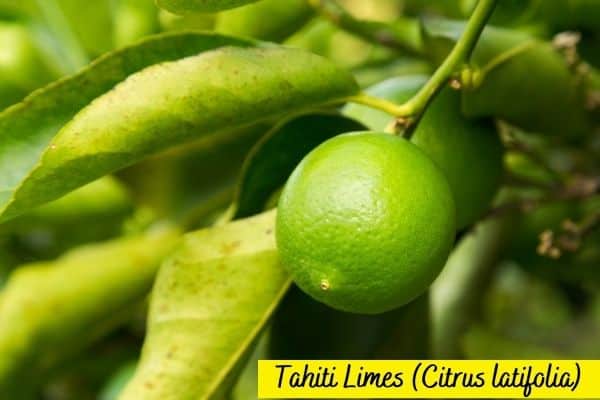4 Types of Lime Trees [Varieties, Pictures + Identification]
Lime trees are hybrids of different types of citron plants. The type of plant species and the genus brings about the different types of lime trees.
There are 4 main types of lime trees which include key limes (Citrus aurantifolia), tahiti lime tree (Citrus latifolia), Thai lime (Citrus hystrix), and Rangpur lime (Citrus × limonia). These varieties are unique in the way they taste, their physical features, and how and where they’re grown.
See the pictures of the different types of lime fruits below.
All limes have a comparable nutritional profile. The only distinguishing factor of the lime tree is its size and shape of the trees. The fruit’s size, shape, color, and rind texture are also the distinguishing features of different types of lime fruits. Flowers can also help classify the different types of lime trees.
Different types of lime trees
Variations in lime trees result from the diverse composition of the hybrid plant species and genus. Below are the different types of lime trees with information on how to identify them, their uses, and where they are grown:
1. Key limes (Citrus aurantifolia)
Key limes of the Rutaceae family are also known as the Mexican lime or the West Indian lime. Mexican lime is a tri-hybrid of three citron plant species of two different genera.

How to Identify Key limes
| Key Lime Features | Characteristics |
| Trees | Evergreen, small and bushy trees. Grows to a height of about 12 to 15 feet. Slender thorny branches A dark brown smooth bark. Compact-shaped trees. |
| Leaves | Oval-shaped, medium dark-green leaves. Narrow leaf stalks (petioles). The leaves resemble those of orange trees. |
| Flowers | White fragrant flowers with a tinge of purple edges. They are small, about 1-inch in diameter. The flowers hold in clusters along the stems. They are perfect flowers with both stamen and pistil parts. They blossom in spring. |
| Fruits | Small and polyembryonic seeds. The fruits are round to oval-shaped. Greenish-yellow fruits to pale yellow when ripe. They are juicy and acidic with a distinctive aroma. They have 8-12 divisions with about 10-15 seeds. |
Uses of Key limes
- Making limeade.
- Flavoring fish, chicken, and meat marinades.
- Garnishing drinks and servings.
- Making the famous key lime pie.
Where are key limes grown?
Key limes thrive well in warm tropical and subtropical regions. Cold temperatures damage their leaves and stems thus limiting their production.
Mexican limes grow in USDA zones 9 to 11 in fertile sandy and rocky well-drained soils but can also grow well in pots with a good citrus fertilizer.
The main regions producing key limes include Mexico, India, North America in Florida, Central America in California, West Indies countries, and Egypt
2. Tahitian Lime (Citrus latifolia)
The Tahitian lime of the Rutaceae family is commonly referred to as the Persian lime. It is a hybrid of the Mexican lime and local lemon or any other citrus plant.

How to identify the Tahitian Lime Tree
| Tahitian Lime features | Characteristics |
| Trees | Dense, evergreen tall trees. Trees grow to a height of about 20 feet. Widespread and rounded branches with few thorns. |
| Leaves | Long and broad, dark green oval-shaped leaves. A narrow leaf stalk (petiole). |
| Flowers | Small white petals with stamens that contain non-viable pollen grains. Green ovary and yellow style and stigma. The flowers hold in clusters next to the plant’s leaves. The flowers bloom in spring. |
| Fruits | Large oval-shaped fruits. Dark green upon maturity and turns greenish-yellow when ripe. Juicy, acidic, and seedless fruits. They have 10-12 segments. |
Uses of the Persian lime
- To flavor fish, meat, and chicken.
- To garnish drinks.
Where are Tahitian lime trees grown?
Persian lime grows well in warm tropical and subtropical regions. The trees are more tolerant of cold weather than the Mexican limes.
Tahiti limes thrive well in a variety of fertile, well-drained with high pH levels. They’re recommended for USDA zones 9 to 11.
You’ll find them thriving in regions such as Florida, Mexico, Egypt, Cuba, Israel, and other areas with a warmer climates.
Read also: Why are the leaves of my citrus tree curling?
3. Thai Lime trees (Citrus hystrix)
The Thai lime of the Rutaceae family is also known as the Kaffir lime or makrut lime.

How to identify Thai lime tree
| Thai Lime Features | Characteristics |
| Trees | Dwarf evergreen trees. Widespread and drooping thorny branches. |
| Leaves | Thick glossy green leaves. Double leaves with a shiny upper side and dull lower side. |
| Flowers | Small white flowers with pink edges. The flowers hold in a cluster along the stem. |
| Fruits | Small round-shaped deep green fruits. The fruits have a rough and bumpy oil rind. The fruits resemble local lemons. |
Uses of Thai limes
- In preparation for Asian cuisine.
- Indonesians use the juice and rinds for medicinal purposes.
- Thai lime has essential oils that are good in perfume production.
Where is Thai lime grown?
Thai lime thrives well in slightly warm regions than other types of limes. It flourishes in zone 10 to 12 of the United States Department of Agriculture plant hardiness.
The Asian-origin citrus plant grows in Southeast Asia and other warmer regions like Florida, Southern China, Israel, California, and Egypt, among other temperate areas.
You still want to make sure you water the citrus tree correctly if you’re growing it indoors to prevent some citrus diseases that can easily kill the plant.
4. Rangpur Lime
Rangpur lime is also known as the mandarin lime, Kona lime, or local lemon. It is a hybrid between a tangerine (mandarin orange) and lemon.
The rangpur tree is medium-sized and can grow to a height of 20 feet. The plant is mainly established from seed, which is why there are few rangpur lime cultivars.

How to identify Rangpur lime tree
| Rangpur Lime features | Characteristics |
| Trees | Medium-sized evergreen trees. Grows to a height of about 15 to 20 feet. Widespread and drooping thorny and slender branches. Resembles tangerine orange trees. |
| Leaves | Dull green oval-shaped leaves with purplish edges. |
| Flowers | Small mandarin-like white flowers. Purple petals and buds. |
| Fruits | Small to medium-sized, round-shaped fruits. Have an orange to reddish-orange rind. Juicy and acidic fruits that are easy to peel. They resemble hybrid oranges and have 8-10 segments. |
Uses of Rangpur Lime
- Making simple syrups incorporated in iced tea and sparkling water.
- In marinating pork, chicken, and fish.
- Garnishing Indian cuisines.
Where are Rangpur lime trees grown?
The mandarin lime grows well in volcanic well-drained soils. It is tolerant to lower temperatures and does well in higher elevations with enough rainfall and nutrients.
The plant goes by different names in different regions: Rangpur in India, Mandarin in the USA, Canton lemon in South China, Cravo lemon in Brazil, and hime lemon in Japan.
What type of fruit is lime?
Lime is a citrus fruit that’s aromatic and beneficial. Citrus fruits contain beneficial vitamins and minerals like calcium and magnesium that help boost immunity, strengthen bones, and heal wounds.
Lime fruits also contain antioxidants that are good for detoxing the body. The aroma of lime fruits makes them suitable for food garnishing and flavoring.
SEE ALSO: Lemon vs Lime Trees: Differences
References
- University of Florida, Extension Services: Key limes/CH/CH09200.pdf
- The University of California Riverside, College of Natural and Agricultural Sciences: Citrus Variety Collection: Rangpur

